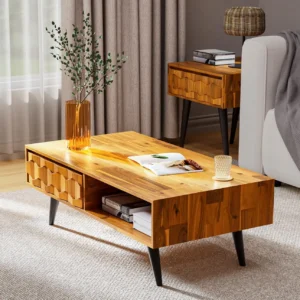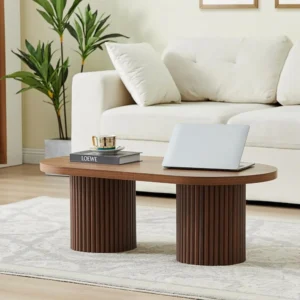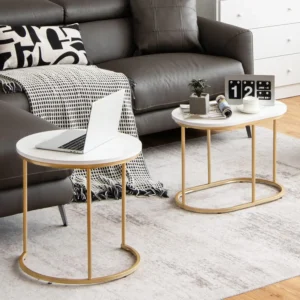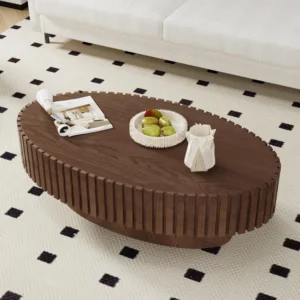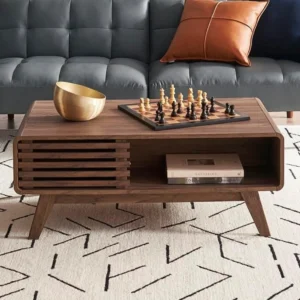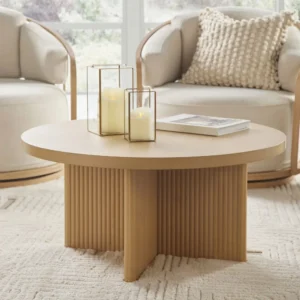Understanding Danish Design Philosophy in Coffee Tables
Danish-inspired coffee tables stand apart in the furniture world thanks to their distinctive blend of beauty and functionality. These pieces represent the heart of mid-century modern design with their clean lines, organic forms, and impeccable craftsmanship.
At its core, Danish design philosophy embraces several key principles that make these coffee tables instantly recognizable:
- Form follows function – Every element serves a purpose; there’s nothing superfluous
- Minimalist aesthetic – Clean lines and uncluttered surfaces let materials and craftsmanship shine
- Human-centered design – Proportions and heights are carefully calibrated for comfort and everyday use
- Respect for materials – Wood grain and natural patterns are celebrated, not hidden
This approach stems from a deeper cultural concept of “hygge” (pronounced hoo-ga), which encompasses feelings of coziness, contentment, and well-being. Danish furniture designers understood that a coffee table isn’t just functional—it’s central to creating moments of connection in the home.
What makes Danish coffee table designs particularly special is how they balance seemingly contradictory qualities. They appear both light and substantial, modern yet timeless, simple yet sophisticated. This delicate balance creates pieces that complement almost any interior style, from minimalist apartments to eclectic family homes.
The enduring appeal of Danish coffee tables lies in their rejection of trendy embellishments in favor of honest materials and thoughtful design. When you invest in a quality piece, you’re bringing home furniture that will look as relevant decades from now as it does today.
Many discerning homeowners choose mid-century modern Danish coffee tables as anchoring pieces in their living spaces, recognizing that these designs have already stood the test of time.
Identifying Authentic Danish Materials: The Wood Story
The story of Danish coffee table design begins with wood selection. Material choice is perhaps the most fundamental element in identifying an authentic Danish-inspired piece, as specific woods were favored for their visual and structural properties.
The most common woods used in Danish coffee tables include:
| Wood Type | Characteristics | Visual Identification |
|---|---|---|
| Teak | Warm honey to orange-brown tones, straight grain with occasional swirls, natural oils | Rich patina develops over time, smooth finish, slightly waxy feel |
| Oak | Light to medium brown, prominent grain patterns, sturdy build | Visible pores in the grain, substantial weight, often paired with lighter finishes |
| Rosewood | Deep reddish-brown with dramatic dark striping, dense hardwood | Striking color variation, high polish potential, often used for statement pieces |
| Walnut | Rich chocolate brown tones, straight to wavy grain patterns | Sophisticated appearance, smooth texture, often used in higher-end pieces |
What makes these woods special in Danish design is how they’re showcased. Unlike heavily stained or painted furniture, Danish craftsmen preferred to highlight wood’s natural beauty through thoughtful cutting, matching, and finishing.
To identify authentic wood in Danish-inspired pieces, examine how the grain flows across surfaces. Quality pieces feature intentional grain matching and continuous patterns. The wood shouldn’t appear uniform or perfect—natural variations indicate genuine materials rather than synthetic alternatives.
Danish tables also develop a distinct patina over time, particularly teak which deepens in color and develops a silky smooth finish with age and use. This natural aging process is highly valued in authentic pieces.
Many furniture enthusiasts specifically seek out mid-century modern teak coffee tables for this reason, as teak exemplifies the warm, inviting quality characteristic of Danish design.
Learning to identify real wood coffee tables is an essential skill for anyone interested in Danish-inspired furniture, as material authenticity is the foundation for all other design elements.
Signature Shapes and Silhouettes to Look For
Danish coffee tables are instantly recognizable by their distinctive silhouettes and proportions. These shapes aren’t merely aesthetic choices—they reflect the Danish commitment to functional, human-centered design.
Common tabletop shapes to look for include:
- Rectangular with rounded corners – The most classic form, offering maximum usable surface while eliminating sharp edges
- Organic “kidney” or “boomerang” – Flowing, asymmetrical shapes that add visual interest while fitting naturally into conversation areas
- Oval or “surfboard” – Elongated shapes with tapered ends, balancing visual lightness with practical surface area
- Perfect circles – Creating a sense of harmony and balance, often featured in nesting table sets
- Soft squares – Square forms with subtly rounded corners that combine geometric precision with organic softness
What truly distinguishes Danish tables is their sense of visual lightness. Despite being solidly constructed, they often appear to “float” in space. This effect comes from the relationship between tabletop and base—typically, the tabletop is thin (usually 3/4” to 1” thick) with a slight taper or bevel at the edges, creating an impression of delicacy.
Proportion is another telling feature. Danish designers understood that a coffee table should be precisely the right height relative to seating (typically 16-18 inches tall) and sized appropriately for the intended space. Nothing appears oversized or undersized.
The elegance of mid-century modern solid wood coffee tables lies in this perfect balance—substantial enough to be functional but visually light enough to keep spaces feeling open and uncluttered.
Leg Designs: The Foundation of Danish Style
If there’s one element that most clearly identifies a Danish-inspired coffee table, it’s the leg design. These supporting structures do far more than just hold up the tabletop—they define the entire aesthetic of the piece.
The most recognizable leg styles include:
- Tapered legs – Narrowing elegantly from top to bottom, creating a sense of visual lightness
- Sculpted organic legs – Featuring gentle curves and organic shaping that showcases the woodworker’s craft
- Compass legs – Splaying outward at precise angles (typically 15-30 degrees), improving stability while creating dynamic visual lines
- Sledge bases – Continuous curved wood forms that create a rocking chair-like base
- Pedestal designs – Central support structures that can range from minimal columns to sculptural forms
What makes these leg designs distinctly Danish is how they connect to the tabletop. Rather than appearing as separate pieces simply attached underneath, quality Danish legs integrate seamlessly with the table structure. This integration is achieved through expert joinery, with legs that appear to emerge organically from the tabletop rather than being bolted on as afterthoughts.
The positioning of legs is equally important. Danish designers often placed legs at the very corners or edges of the table, creating the impression that the tabletop is floating in space. This placement also maximizes floor visibility, making rooms appear more spacious.
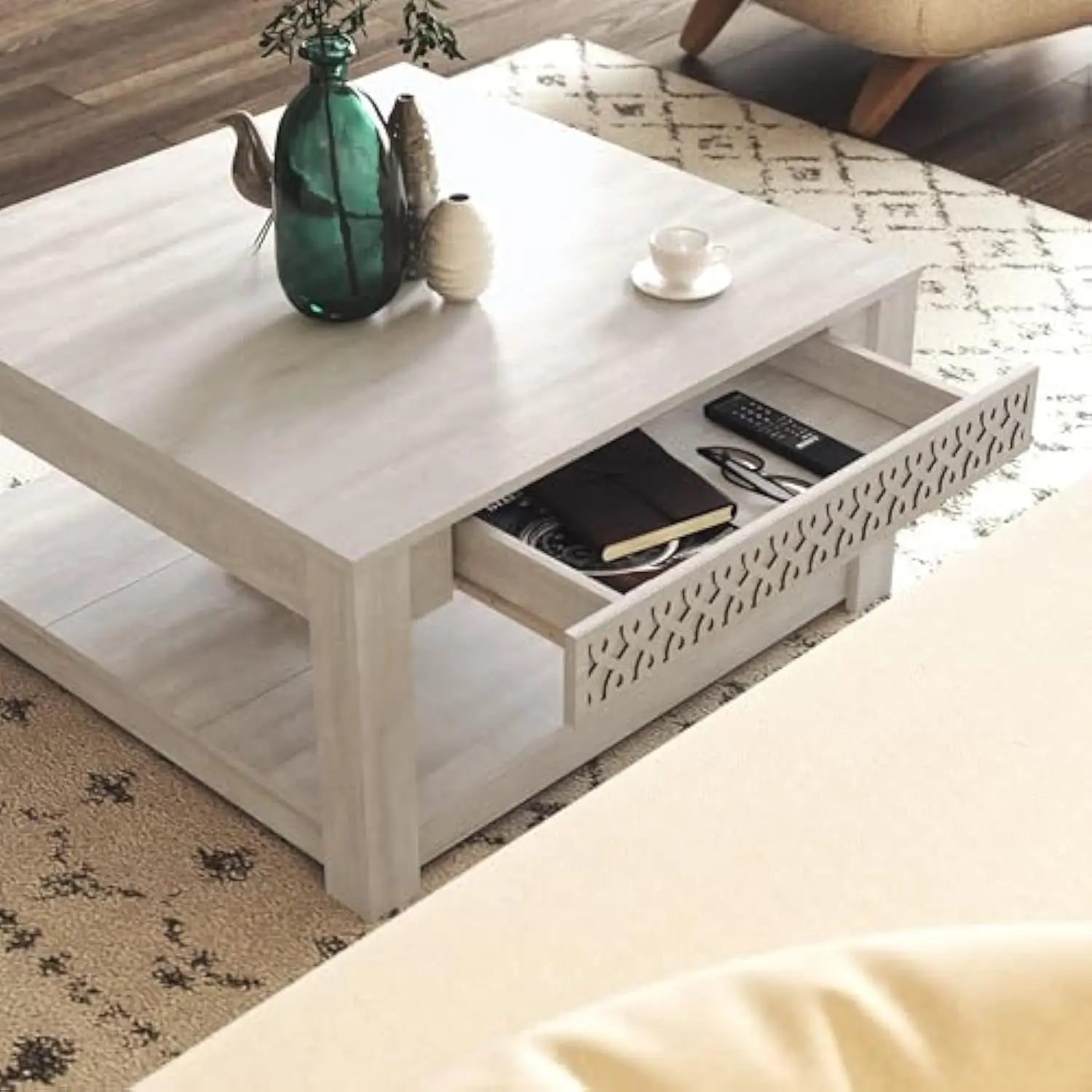
Understanding the nuanced Danish modern coffee table elements helps collectors and enthusiasts identify authentic pieces amid the many imitations on the market.
Construction Details That Reveal Authenticity
The true mark of a Danish-inspired coffee table lies in its construction details—elements that may not be immediately visible but reveal the quality and authenticity of the piece.
Danish design emphasizes joinery as both a functional and aesthetic element. Rather than relying on screws, nails, or other hardware, traditional Danish tables use sophisticated woodworking joints that provide both strength and beauty.
Key joinery techniques to look for include:
- Finger joints – Interlocking “fingers” of wood that create exceptionally strong corners
- Mortise and tenon joints – Where one piece has a projecting tenon that fits precisely into a mortise (hole) in the adjoining piece
- Dovetail joints – Wedge-shaped interlocking components most commonly found in drawer construction
- Dowel reinforcement – Wooden pins that strengthen connections while remaining nearly invisible
In authentic Danish pieces, these joints aren’t hidden—they’re often highlighted as design features. The precision of these connections speaks to the craftsperson’s skill, with tight, nearly seamless fits that require minimal glue.
Another telltale sign of quality construction is the approach to hardware. True Danish-inspired pieces minimize visible hardware, often incorporating innovative mechanisms that eliminate the need for obvious handles or pulls. When hardware is present, it’s typically simple, elegant, and made from quality materials like brass or steel.
Even the underside of the table reveals clues about authenticity. Look for consistent finishing on all surfaces (not just visible ones) and attention to detail even in hidden areas. Quality Danish coffee table construction craft means no rough or unfinished spots, regardless of visibility.
Functional Elements and Innovative Features
Danish design brilliantly balances form and function, often incorporating clever features that enhance usability without compromising aesthetic purity. These functional elements represent Danish designers’ commitment to creating furniture that serves real-life needs.
Common functional features in Danish coffee tables include:
- Concealed storage drawers – Often so well integrated that they’re nearly invisible when closed
- Magazine shelves – Lower platforms or slatted surfaces for storing reading materials while keeping them accessible
- Expanding or adjustable tabletops – Mechanisms allowing the surface to extend or change height
- Reversible tops – Different finishes or materials on each side for versatility
- Nesting configurations – Multiple tables designed to stack together when not in use
What makes these features distinctly Danish is how seamlessly they’re integrated into the overall design. Unlike some furniture that looks functional but sacrifices beauty, Danish pieces incorporate practical elements without visual compromise.
For example, a drawer in a Danish coffee table won’t have obvious pulls or handles—instead, it might feature a recessed grip underneath the edge or a subtle push-release mechanism. Similarly, a magazine shelf won’t appear as an afterthought but as an integral part of the table’s structure.
This thoughtful approach to design makes mid-century modern nesting coffee tables particularly popular among those with limited space. These pieces offer flexibility without sacrificing the clean aesthetic that defines Danish style.
Danish vs. Other Design Styles: Spotting the Differences
Danish coffee tables share many attributes with other mid-century and Scandinavian styles, making precise identification sometimes challenging. Understanding the subtle differences helps distinguish truly Danish-inspired pieces from their similar-looking cousins.
| Design Style | Materials | Proportions | Distinctive Features |
|---|---|---|---|
| Danish | Teak, rosewood, oak; emphasis on wood grain | Modest scale, thin tops, precise proportions | Tapered legs, minimal ornamentation, seamless joinery |
| American Mid-Century | Walnut predominates; sometimes incorporates formica | Often more substantial, dramatic proportions | Heavier profiles, sometimes more decorative hardware |
| Swedish | Lighter woods like birch and pine | Similar scale to Danish but often lighter in appearance | More decorative elements, sometimes painted surfaces |
| Norwegian | Oak, pine, birch | Tends toward sturdier proportions | More rustic details, sometimes carved elements |
| Contemporary Reproductions | Various woods, often veneered | May exaggerate proportions for dramatic effect | Often lacks the refinement in joinery and edge profiles |
What truly distinguishes Danish design is its restraint. While American mid-century pieces might incorporate bold colors or contrasting materials, Danish tables let the natural beauty of wood take center stage. Swedish pieces might feature more decorative elements, while Danish design strips away anything unnecessary.
Another telling difference lies in the finish quality. Danish pieces typically feature oil finishes that penetrate the wood rather than sitting on top like a lacquer or varnish. This creates a silky, natural feel that deepens with age rather than the high-gloss appearance common in some other styles.
Understanding the subtle differences between Scandinavian Danish coffee table design traditions helps collectors make informed decisions and appreciate the nuances of these related but distinct aesthetics.
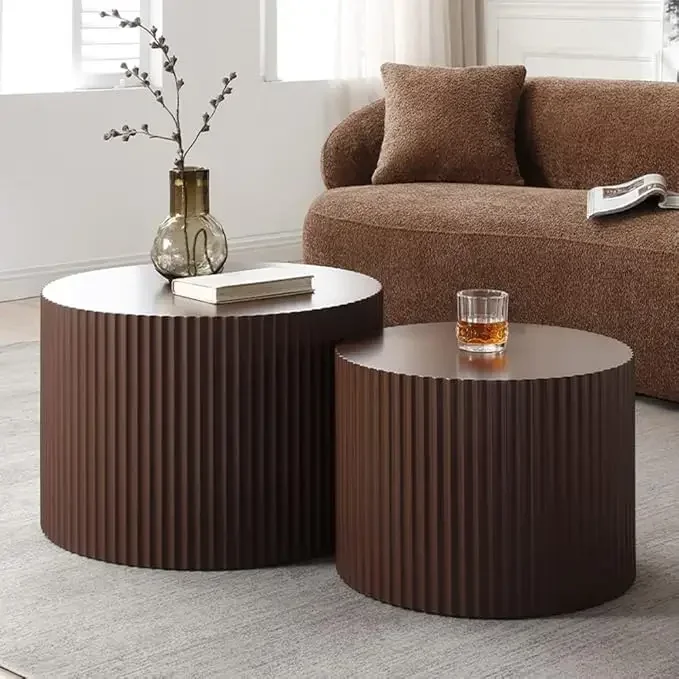
Examining Finish Quality and Surface Details
The finish of a Danish-inspired coffee table tells a story about its quality and authenticity. Danish craftsmen developed distinctive approaches to wood finishing that enhance natural beauty while providing practical protection.
Traditional Danish finishes include:
- Oil finishes – Usually tung oil or linseed oil that penetrates the wood rather than forming a surface film
- Oil-wax combinations – Providing slightly more protection while maintaining the natural look and feel
- Soap finishes – A traditional Scandinavian technique creating a matte, ultra-natural appearance
- Light lacquer – Used sparingly to protect while maintaining the wood’s natural appearance
What distinguishes authentic Danish finishing is its subtlety. The goal is not a thick, glossy protective layer but rather a finish that makes the wood look almost bare—yet protected and enhanced. When you touch a properly finished Danish table, you should feel the warmth and texture of the wood itself, not a plastic-like coating.
Surface details reveal much about quality as well. Examine edge treatments closely—authentic Danish pieces typically feature softly rounded or beveled edges rather than sharp 90-degree corners. These subtle edge profiles require more craftsmanship but create a more inviting, tactile experience.
Another quality indicator is grain matching. On veneered surfaces, high-quality Danish pieces feature book-matched or slip-matched veneers where the grain patterns create intentional symmetrical or flowing patterns. This attention to detail is particularly evident on tabletops, where the grain direction and pattern should appear thoughtfully considered.
Learning about common wood finishes coffee tables can help collectors appreciate the subtle differences that distinguish exceptional Danish craftsmanship.
Quality Markers: What Experts Check First
Professional furniture appraisers and collectors have developed efficient methods for quickly identifying authentic Danish-inspired coffee tables. These quality markers serve as a practical checklist when evaluating pieces.
Weight and substance – Despite their visual lightness, quality Danish pieces have surprising heft due to solid wood construction and proper joinery. Lift one end of the table—it should feel substantial and balanced.
Joint inspection – Examine where legs meet the tabletop. Quality pieces show precise joinery with tight, nearly invisible seams. Pull gently on legs to check for sturdiness—there should be no movement or creaking.
Underside examination – Flip the table over and check the underside. Authentic pieces are finished consistently throughout, though perhaps with slightly less refinement on hidden surfaces.
Edge profiles – Run your hand along the table’s edges. Danish pieces typically feature subtle bevels or rounded edges that feel pleasant to touch, never sharp or square.
Patina assessment – On vintage pieces, look for consistent aging across all surfaces. The patina should appear natural and even, not artificially distressed or uneven.
Hardware quality – If present, hardware should be minimal, well-crafted, and age-appropriate. Mass-produced pieces often cut corners with cheap hardware.
Maker’s marks – Though not always present, some Danish pieces bear manufacturer stamps, designer labels, or country-of-origin markings, typically found on the underside.
These evaluation techniques reflect the comprehensive approach detailed in guides about key characteristics Danish coffee tables, which emphasize both visual and tactile assessment.
Contemporary Danish-Inspired Pieces: Modern Interpretations
While vintage Danish coffee tables remain highly sought-after, contemporary designers continue to create beautiful pieces inspired by Danish design principles. These modern interpretations honor traditional craftsmanship while addressing contemporary needs and aesthetics.
Quality contemporary Danish-inspired pieces maintain core elements like:
- Clean, minimalist forms that emphasize function
- Honest use of materials with visible wood grain
- Precise joinery and thoughtful construction
- Human-centered proportions and scale
However, modern interpretations may introduce new elements:
- Sustainable wood alternatives to traditional teak and rosewood
- Integration of modern materials like glass, metal, or engineered woods
- Adaptations for contemporary living (technology accommodation, multi-functional designs)
- New finishing techniques that maintain the Danish aesthetic while offering improved durability
What distinguishes quality contemporary pieces from generic “mid-century style” furniture is attention to detail. Mass-produced items may mimic Danish shapes but typically lack the refined proportions, quality materials, and construction expertise that define true Danish inspiration.
The best modern Danish coffee table design approaches honor tradition without slavishly copying it. They understand the principles behind Danish furniture and apply them thoughtfully to create pieces that feel both timeless and relevant for today’s homes.

Where to Find Authentic Danish-Inspired Coffee Tables
Finding quality Danish-inspired coffee tables requires knowing where to look and what questions to ask. Whether you’re seeking vintage pieces or contemporary interpretations, these guidelines will help you source authentic options.
Quality Danish-inspired coffee tables can be found through:
- Specialized retailers focusing on mid-century or Scandinavian design
- Vintage furniture dealers with expertise in Danish modern
- Auctions and estate sales in areas with strong mid-century history
- Custom furniture makers specializing in Danish-inspired designs
- Carefully curated online marketplaces with proper authentication
When evaluating a potential purchase, ask these key questions:
- What specific woods are used in this piece?
- How is the tabletop connected to the base/legs?
- What type of finish has been applied?
- For vintage pieces: Has the piece been restored, and if so, how?
- For contemporary pieces: How does the design honor Danish traditions?
Be wary of retailers who can’t answer specific questions about materials and construction methods. Quality sellers like Hearth Forms pride themselves on understanding the design heritage and craftsmanship behind each piece they offer.
For those seeking furniture that complements minimalist interiors, Danish coffee tables minimalist design principles offer ideal solutions that balance simplicity with visual interest.
Mid-Century Modern Solid Wood Coffee Tables, Mid-Century Modern Teak Coffee Tables
$879.95 Select options This product has multiple variants. The options may be chosen on the product pageMid-Century Modern Danish Coffee Tables, Mid-Century Modern Oval Coffee Tables, Mid-Century Modern Solid Wood Coffee Tables
$390.05 Select options This product has multiple variants. The options may be chosen on the product pageMid-Century Modern Nesting Coffee Tables, Mid-Century Modern Nesting Table Sets
$361.45 Select options This product has multiple variants. The options may be chosen on the product pageMid-Century Modern Oval Coffee Tables, Mid-Century Modern Solid Wood Coffee Tables
$679.56 Select options This product has multiple variants. The options may be chosen on the product pageMid-Century Modern Solid Wood Coffee Tables, Mid-Century Modern Walnut Coffee Tables
$501.53 Select options This product has multiple variants. The options may be chosen on the product pageMid-Century Modern Round Coffee Tables, Mid-Century Modern Solid Wood Coffee Tables
Price range: $522.31 through $559.78 Select options This product has multiple variants. The options may be chosen on the product page
Your Danish Coffee Table Identification Checklist
Use this practical checklist when identifying or shopping for Danish-inspired coffee tables:
Materials:
– [ ] Primary construction in teak, oak, rosewood, or walnut
– [ ] Visible, natural wood grain (not heavily painted or disguised)
– [ ] Consistent wood quality throughout (not just on visible surfaces)
– [ ] Smooth, silky finish that enhances rather than masks wood character
Form:
– [ ] Clean, uncluttered silhouette with no unnecessary ornamentation
– [ ] Thin tabletop profile (typically ¾” to 1”) with subtle edge detailing
– [ ] Balanced proportions (typically 16-18” height, appropriate to sofa height)
– [ ] Visual “lightness” despite solid construction
Legs/Base:
– [ ] Tapered, splayed, or sculpturally shaped legs
– [ ] Legs positioned to create floating appearance
– [ ] Seamless integration of legs with tabletop
– [ ] Stable base with no wobbling or imbalance
Construction:
– [ ] Quality joinery (finger joints, mortise and tenon, dovetails)
– [ ] Minimal visible hardware
– [ ] Consistent craftsmanship on visible and hidden surfaces
– [ ] Solid feel with no creaking or movement at joints
Functionality:
– [ ] Practical features integrated without disrupting clean lines
– [ ] Thoughtful details that enhance usability
– [ ] Appropriate scale for human use and comfort
– [ ] Durability in daily use
This checklist synthesizes the elements covered in our Danish coffee table design guide and provides a practical tool for evaluating potential purchases.
Is This Coffee Table Truly Danish-Inspired? Common Questions Answered
Q: Can authentic Danish-inspired coffee tables be made from materials other than wood?
A: While wood predominates, Danish designers occasionally incorporated other materials like glass, marble, or metal. However, these materials were typically used as accents or secondary elements, with wood remaining the primary material. Even pieces with glass or stone tops usually feature wooden bases or legs that display characteristic Danish design elements.
Q: Do all Danish coffee tables have tapered legs?
A: No, though tapered legs are common. Authentic Danish design includes various leg styles including straight legs, sculpted organic forms, sledge bases, and pedestal supports. What matters more than the specific leg shape is how well the legs integrate with the overall design and how they contribute to the table’s visual lightness.
Q: How can I distinguish between Danish, Swedish, and Norwegian designs?
A: Danish pieces typically feature darker woods (especially teak), minimal ornamentation, and refined proportions. Swedish designs often use lighter woods and may include more decorative elements. Norwegian pieces tend toward sturdier proportions and sometimes incorporate carved details. The definitive guide Scandinavian coffee tables offers more detailed comparisons.
Q: Are there specific dimensions that define Danish coffee tables?
A: While there’s no rigid formula, Danish coffee tables typically stand 16-18 inches tall to complement standard sofa heights. Proportionally, they tend to favor modest scale rather than oversized statement pieces, though dimensions vary based on function and intended placement.
Q: Does the presence of visible hardware mean a piece isn’t authentically Danish-inspired?
A: Not necessarily. While Danish design minimizes hardware, some authentic pieces do include visible elements like drawer pulls or shelf supports. The key is whether these elements are thoughtfully integrated into the design, made from quality materials, and serve a necessary function rather than appearing decorative.
Preserving Your Danish Coffee Table: Care Fundamentals
Proper care not only protects your Danish coffee table investment but also preserves the very qualities that make it distinctive. These care principles help maintain the material integrity and design character that define Danish pieces.
Wood Maintenance:
* Apply appropriate oil treatments every 6-12 months to nourish the wood
* Use specific products based on your table’s wood type (teak oil for teak, etc.)
* Wipe up spills immediately to prevent staining or water damage
* Maintain consistent indoor humidity levels (40-60%) to prevent wood movement
Daily Care:
* Use coasters for hot or wet items to protect the finish
* Dust regularly with a soft, slightly damp cloth
* Clean with mild soap and water only when necessary
* Avoid commercial furniture polishes containing silicone or wax
Preventive Measures:
* Position your table away from direct sunlight to prevent uneven fading
* Use felt pads under objects to prevent scratching
* Lift rather than drag items across the surface
* Consider seasonal rotation to ensure even aging if the table is in a sunny location
The Danish approach to furniture embraces natural aging and patina development. Unlike some furniture that tries to maintain a “new” appearance indefinitely, quality Danish pieces often become more beautiful with age as the wood develops character and depth of color.
By understanding how to care for these special pieces, you ensure they’ll continue bringing beauty and function to your home for generations to come.


